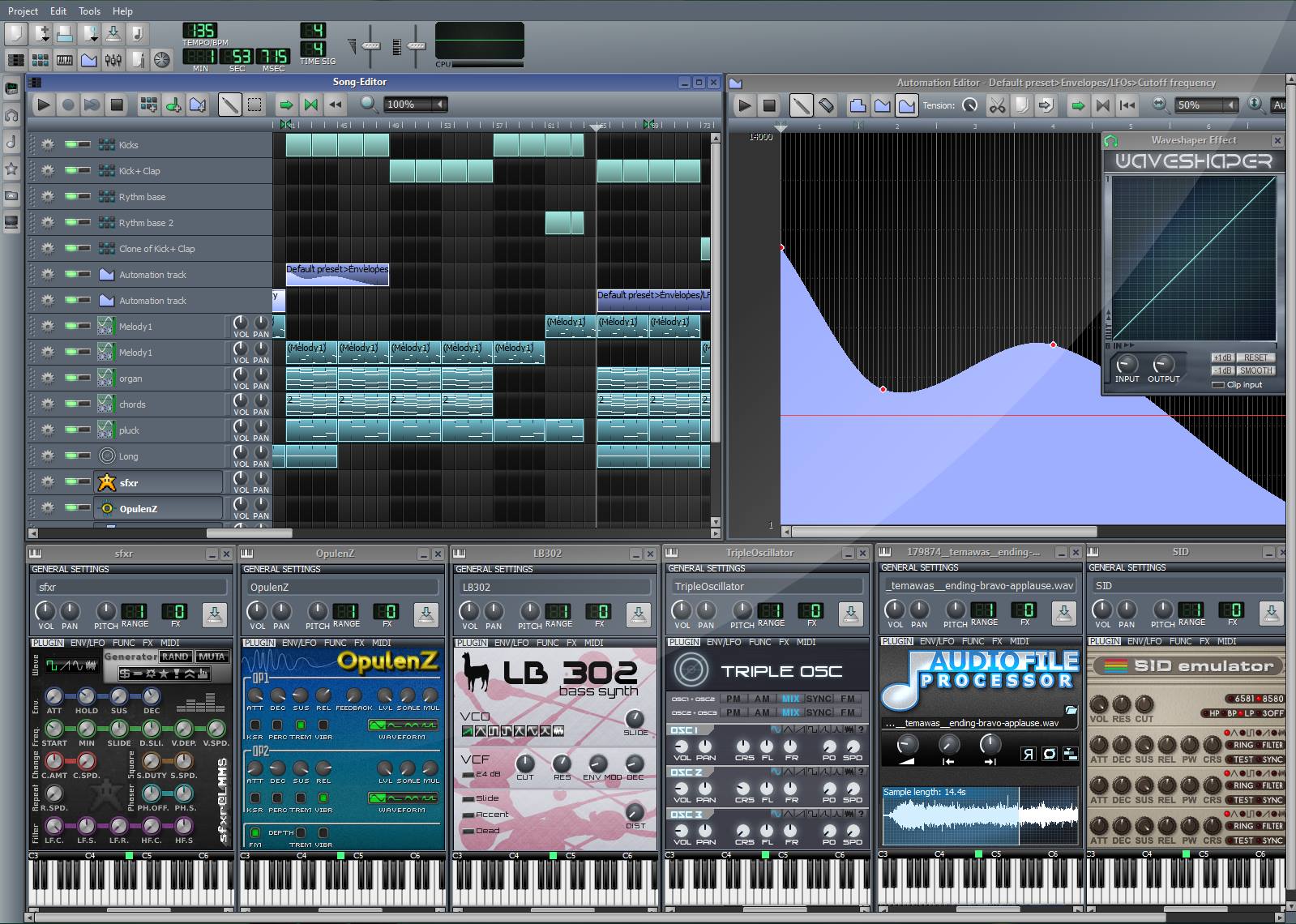LMMS is a free cross-platform alternative to commercial program like FL Studio, which allow you to produce music with your computer. This includes the creation of melodies and beats, the synthesis. DarkWave Studio is a workstation to create music suitable for any kind of user. It supports 'ASIO Audio Drivers' and 'VST PlugIn', which will allow us to use a huge range of musical instruments. Share and discuss your LMMS music projects here, and see what people think! 3976: 17770: Last post New song - Tony's Delivery by Rafaelcortazio Wed Apr 21, 2021 4:51 pm. LMMS is a free cross-platform software which allows you to produce music with your computer. This covers creating melodies and beats, synthesizing and mixing sounds and arranging samples. You can have fun with your MIDI keyboard and much more – all in a user-friendly and modern interface.
Impressive freeware for making music
LMMS is a simple yet powerful digital audio workstation (DAW). If you are looking for a basic foundation in music composition and sound production, LMMS is a great (and free) way to dip your toe in the water. Ready to see if it's worth taking the plunge? Read on and find out!
Feature-packed freeware for blending beats and making sounds
LMMS is a one-stop shop for music composition and blending beats. Get ready to make some noise!

LMMS is the Swiss army knife of music production. Atv flash black 2.6 download. It is a cross-platform and entirely free application for creating or editing songs and mixing sounds. In essence, it operates as a digital-audio doodle pad. Once you download the software to your laptop or PC, you will have a plethora of features at your musical fingertips. The LMMS program allows you to make music using the various controls for song editing, mixing and more. You can blend sounds and clips, use repetitive elements like drum beats, tweak volumes or merge special effects.

It is true that for all its gleaming positives – an extensive database of sounds, external plugins, and the piano roll where you can play 808 notes – LMMS is not hugely intuitive. For total beginners the interface may be forbiddingly complex, and the “Getting Started” guide while comprehensive, is dauntingly detailed. You have the “Manual” which contains “short” pages on each topic, from a step-by-step guide to making your first song for beginners, or guides on creating triple-oscillator patches for the more advanced. True to the principles of open source software, LMMS is utterly transparent and includes thematic descriptions of every feature. You can view the source code and even work on LMMS yourself.
For budding musicians: LMMS helps you compose and arrange your own original song from scratch, or design a totally unique sound. You can dabble with the built-in samples or tickle the digital ivory of the online keyboard. There is also an FX mixer where you can create as many channels as you like. Another beautiful aspect of the freeware is the accompanying supportive community of volunteer developers and users. You can ask for help in the LMMS homepage forums, or upload your projects to the forums on Facebook and SoundCloud for feedback. Once you have mastered the basics, it is worth checking out the configuration and customizing yourself some neat keyboard shortcuts.
LMMS gives you pretty much all the resources you need for song creation and sound production: song elements and sound-clips, a synth algorithm, and an option to export MIDI files. What’s the catch? As the saying goes, “you get what you pay for”. The user-interface is arguably unfriendly; however, the program does lack some of the automated features and audio recording options that you would get with paid DAWs.
Where can you run this program?
You can run it on a Windows PC or laptop (32-bit or 64-bit), MacOS (versions 10.13 or 10.8) and Linux. For Linux, LMMX is available on a wide variety of repositories (including Ubuntu, OpenSUSE, Arch Linux, and Slackware). If you want to run LMMS on Linux Mint or Debian-based distributions, there is a separate installation package. Alternatively, you can even build LMMS for Linux from the open source.
Is there a better alternative?
LMMS is certainly an excellent option for music production. To recap, you can compose original music through song creation, sound blending or importing MIDI or Hydrogen files. It offers 16 synthesizers and the much-lauded plugin “ZynAddSubFx” – a unique feature. All of which will set you back a whopping zero dollars. For free software it is hard to beat. If you are looking for cream-of-sound production (and you are willing to pay the price), then FL Studio and Pro Tools are both top-notch programs and considered some of the best software in the industry. If you are looking specifically to compose music, then you should consider Cubase or Logic Pro X. Mac users may be more comfortable with the sleek and simple GarageBand. Reaper is another excellent program. It may not be totally free like LMMS, but it is an affordable alternative that allows for more automated control.
Our take
According to LMMS, 'Making beats has never been easier'. Well, we wouldn’t entirely agree. Sure, with the right experience and know-how you have all the resources to produce an original piece of music or create your own unique sounds. With LMMS you can mix beats, arrange song samples or type out your own melody on a MIDI keyboard. This is not immediately obvious, and total beginners should be warned that the interface may be slightly overwhelming. The beauty of open-source software does mean that LMMS has a supportive community at hand to help.
Should you download it?
Yes, download it. LMMS is a resource-rich tool for making music on your computer.
Highs
- Open-source
- Comprehensive database of sounds
- Information-rich guidelines
Lows
- Clunky interface
- Information overload
- No option to record audio
Lmms Beat Maker
LMMSfor Windows

Lmms Developers
1.2.2
